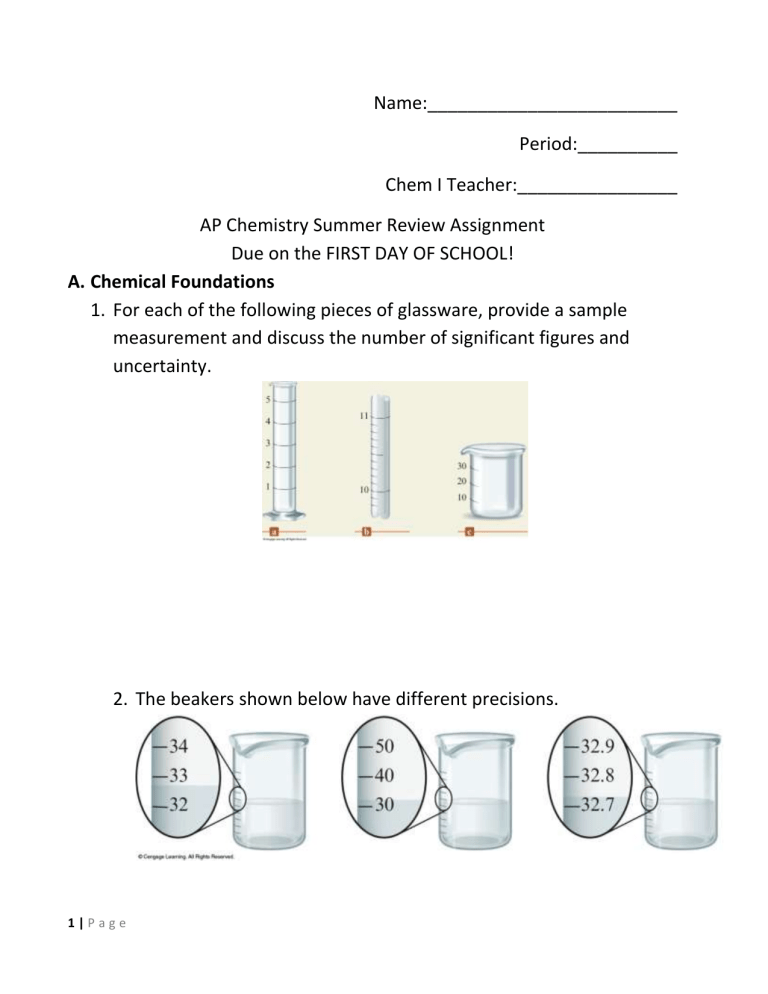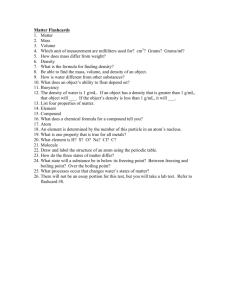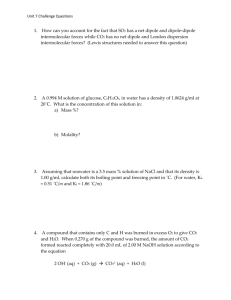Summer Assignment Review Questions

Name:_________________________
Period:__________
Chem I Teacher:________________
AP Chemistry Summer Review Assignment
Due on the FIRST DAY OF SCHOOL!
A.
Chemical Foundations
1.
For each of the following pieces of glassware, provide a sample measurement and discuss the number of significant figures and uncertainty.
2.
The beakers shown below have different precisions.
1 | P a g e
a.
Label the amount of water in each of the three beakers to the correct number of significant figures. b.
Is it possible for each of the three beakers to contain the exact same amount of water? If no, why not? If yes, did you report the volumes as the same in part a? Explain. c.
Suppose your pour the water from these three beakers into one container. What should the volume in the container reported to the correct number significant figures?
3.
Perform the following unit conversion. a.
908 oz to kg b.
2.89 gal to mL c.
550 mL to quarts
4.
In each of the following pairs, which has the greater mass? a.
1.0 kg of feathers or 1.0 kg of lead b.
1.0 mL of mercury or 1.0 mL of water c.
19.3 mL of water or 1.0 mL of gold
2 | P a g e
5.
Match each description below with the following microscopic pictures. More than one picture may fit each description. A picture may be used more than once or not used at all. a.
A gaseous compound b.
A mixture of two gaseous elements c.
A solid element d.
A mixture of a gaseous element and a gaseous compound
B.
Atoms, Molecules & Ions
6.
The number of protons in an atom determines the identity of the atom. What does the number and arrangement of the electrons in an atom determine? What does the number of neutrons in an atom determine?
3 | P a g e
7.
The compounds AlCl
3
, CrCl
3
, and ICl
3
have similar formulas, yet each follows a different set of rules to name it. Name these compounds, and then compare and contrast the nomenclature rules used in each case.
8.
Write the atomic symbol (
𝐴
𝑍
𝑋 ) for each of the isotopes described below. a.
#p + = 27, #n 0 = 31 __________ b.
The isotope of boron with a mass number of 10 _________ c.
Z = 12, A = 23 ___________ d.
Atomic number 53, number of neutrons = 79 ______ e.
Z = 20, number of neutrons = 27 ______ f.
#p + = 29, mass # = 65 ________
9.
How many protons, neutrons, and electrons are in each of the following atoms or ions? a.
24
12
𝑀𝑔 _________________________ b.
24
12
𝑀𝑔 2+ _________________________ c.
59
27
𝐶𝑜 3+ _________________________ d.
79
34
𝑆𝑒 2 _________________________
4 | P a g e
10.
Write the name or formula for the following compounds. a.
Strontium fluoride _________ b.
FeBr
3
____________________ c.
Chromium(VI) oxide _____________ d.
SO
2
_______________________ e.
Aluminum nitride _____________ f.
SnO
2
____________________ g.
Pb
3
(PO
4
)
2
___________________________ h.
Sodium hydride ___________________ i.
Gallium arsenide __________________ j.
KMnO
4
____________________________
11.
Each of the following compounds is incorrectly named. What is wrong with each name, and what is the correct name for the compound? a.
NO
2
nitrogen(IV) oxide – b.
CaO calcium(II) monoxide – c.
P
2
S
5
phosphorus sulfide(V) – d.
Na
2
C
2
O
4
disodium dicarbon tetroxide -
5 | P a g e
C.
Stoichiometry
12.
Consider an iron bar on balance as shown.
As the iron bar rusts, which of the following is true? Explain your answer. a.
The balance will read less than 75.0 g. b.
The balance will read 75.0 g. c.
The balance will read greater then 75.0 g. d.
The balance will read greater than 75.0 g, but if the bar is removed and the rust is scraped off, and the bar replaced, the balance will read 75.0 g.
13.
Describe 1 mole of CO
2
in as many ways as you can.
6 | P a g e
14.
How many atoms of nitrogen are present in 5.00 g of each of the following? Show your work! a.
Glycine, C
2
H
5
O
2
N b.
c.
d.
Magnesium nitride
Calcium nitrate
Dinitrogen tetroxide
15.
Balance each of the following equations. a.
__Ca(OH)
2
(aq) + __H
3
PO
4
(aq) __H
2
O(l) + __Ca
3
(PO
4
)
2
(s) b.
__CaO(s) + __C(s) __CaC
2
(s) + __CO
2
(g) c.
__FeCO
3
(s) + __H
2
CO
3
(aq) __Fe(HCO
3
)
2
(aq) d.
__KClO
3
(s) __KCl(s) + __O
2
(g) e.
__Eu(s) + __HF(g) __EuF
3
(s) + __H
2
(g)
7 | P a g e
f.
Combustion Reaction
16.
A compound contains only carbon, hydrogen, and oxygen.
Combustion of 10.68 mg of the compound yields 16.01 mg CO
2 and 4.27 mg H
2
O. The molar mass of the compound is 176. 1 g/mol. What are the empirical and molecular formulas of the compound? Show work!
8 | P a g e
17.
Sulfur dioxide gas reacts with solid sodium hydroxide to from solid sodium sulfite and water. Assuming you react 38.3 g of sulfur dioxide with 32.8 g sodium hydroxide and assuming the reaction goes to completion, calculate the mass of each product formed. Start by writing the balanced chemical equation. Show work!
9 | P a g e
18.
Consider a gaseous binary compound with a molar mass of
62.09 g/mol. When 1.39 g of this compound is completely burned in excess oxygen, 1.21 g of water is formed. Determine the formula of the compound. Assume water is the only product that contains hydrogen. Show your work! Explain your answer!
D.
Chemical Reactions and Solution Stoichiometry
19.
Draw a molecular-level picture to differentiate between concentrated and dilute solutions.
20.
Show how each of the following strong electrolytes “breaks up” into its component ions upon dissolving in water by drawing molecular level pictures. a.
MgCl
2 b.
Al(NO
3
)
3 c.
NH
4
C
2
H
3
O
2
10 | P a g e
21.
Calculate the concentration, in molarity, of all ions present in each of the following solutions. Assume they are strong electrolytes. a.
0.100 mole of Ca(NO
3
)
2
in 100.0 mL of solution b.
1.00 g K
3
PO
4
in 250.0 mL of solution
22.
Write the net ionic equations for the reaction that occurs when aqueous solutions of the following are mixed. (You may need/use your solubility table. If you need another one, I’ll have it online.) a.
Chromium(III) chloride and sodium hydroxide b.
Strontium nitrate and potassium iodide
23.
What volume of 0.150 M HNO
3
(strong acid) will react completely with 50.00 mL of 0.213 M NaOH?
11 | P a g e
E.
The Gas Laws
24.
Complete the following table for an ideal gas. Show your work below.
Pressure a. 5.00 atm b. c.
228 torr
4.47 atm d. Find atm
Volume
Find L
2.00 L
2.25 L
2.25 n (mol)
2.00
Find n
2.01
10.5
T
155⁰C
155 K
Find ⁰C
75⁰C
25.
An ideal gas is contained in a cylinder with a volume of 5.0x10
2 mL at a temperature of 30.⁰C and a pressure of 710. Torr. The gas is then compressed to a volume of 25.0 mL, and the temperature is raised to 820.⁰C. What is the new pressure of the gas?
12 | P a g e
26.
Consider the flasks in the following diagram. What are the final partial pressures of H2 and N2 after the stopcock between the two flasks is opened? (Assume the final volume is 3.00 L.) What is the total pressure in torr?
27.
The oxides of Group 2A metals (symbolized by M below) react with carbon dioxide according to the reaction:
MO(s) + CO
2
(g) MCO
3
(s)
A 2.85 g sample containing only MgO and CuO is placed in a
3.00 L container. The container is filled with CO
2
to a pressure of 740. Torr at 20⁰C. What is the mass percent of MgO in the mixture? Assume only MgO reacts with the CO
2
.
13 | P a g e
F.
Atomic Structure and Periodicity
28.
Assume that the electron from the hydrogen atom has been excited to the n=5 level. How many different wavelengths of light can be emitted as this excited electron loses energy. Hint: it will be helpful to make a sketch.
29.
Write the full electron configuration, the noble gas notation, orbital box diagram, electron dot structure, and circle the valence electrons for the following elements. Apply the Aufbau principle, Pauli exclusion principle, and Hund’s rule as necessary.
Example: Boron: 1s 2 2s 2 2p 1 (Full) [He]2s 2 2p 1 (Noble Gas notation) ·B·
·
↑↓ ↑↓ ↑
1s 2s
Valence e a.
Potassium
2p b.
Copper
14 | P a g e
c.
Silver d.
Iodine e.
Lead
30.
What rule is being violated in each of the following groundstate configurations? a.
↑↓ ↑↓ ↑↓ ↓
1s 2s 2p 3s 3p b.
↑↓ ↑↓ ↑
1s 2s
15 | P a g e c.
↑↓ ↑↓ ↑↑
1s 2s
↓
2p
2p
↑
3s
3s
3p
3p
d.
↑↓ ↑↓ ↑
1s 2s
↑
2p
↑
3s 3p
31.
Given the valence electron level diagram and the description, identify the element or ion. a.
ground state atom
3s 3p b.
an atom in an excited state (assume two electrons occupy the 1s orbital)
2s 2p c.
a ground-state ion with an charge of -1
4s 4p
32.
Arrange the following in order of increasing size and increasing first ionization energy. a.
Te, S, Se b.
K, Br, NI c.
Ba, Si, F
16 | P a g e





